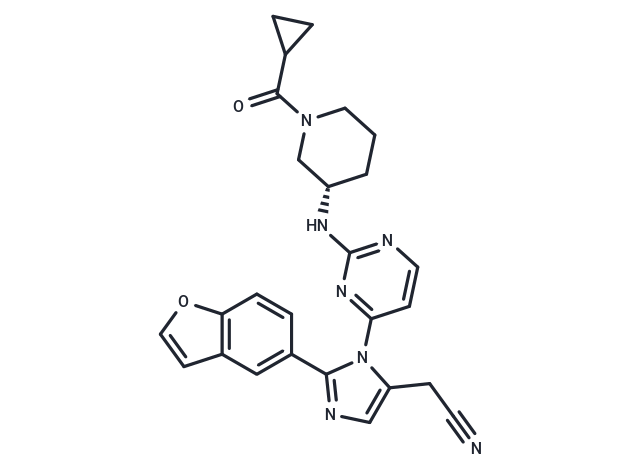Shopping Cart
Remove All Your shopping cart is currently empty
Your shopping cart is currently empty
JNK3 Inhibitor-3 (compound 15g) is a selective, blood-brain barrier permeable, and orally active inhibitor of c-Jun N-terminal kinase 3 (JNK3) with IC50 values of 147.8 nM, 44.0 nM, and 4.1 nM against JNK1, JNK2, and JNK3, respectively. This compound has been shown to significantly enhance memory in mouse models of dementia and is utilized in Alzheimer's disease research [1].

| Pack Size | Price | USA Warehouse | Global Warehouse | Quantity |
|---|---|---|---|---|
| 25 mg | $1,520 | 8-10 weeks | 8-10 weeks | |
| 50 mg | $1,980 | 8-10 weeks | 8-10 weeks | |
| 100 mg | $2,500 | 8-10 weeks | 8-10 weeks |
| Description | JNK3 Inhibitor-3 (compound 15g) is a selective, blood-brain barrier permeable, and orally active inhibitor of c-Jun N-terminal kinase 3 (JNK3) with IC50 values of 147.8 nM, 44.0 nM, and 4.1 nM against JNK1, JNK2, and JNK3, respectively. This compound has been shown to significantly enhance memory in mouse models of dementia and is utilized in Alzheimer's disease research [1]. |
| Targets&IC50 | JNK3:4.1 nM, JNK2:44 nM, JNK1:147.8 nM |
| In vitro | JNK3 inhibitor-3, at concentrations ranging from 0 to 10 μM, exhibits inhibitory effects on JNK1, JNK2, and JNK3, with respective IC50s of 147.8, 44.0, and 4.1 nM. Additionally, at a 20 μM concentration and exposure times of 24 and 48 hours, the compound displays neuroprotective properties in vitro [1]. |
| In vivo | JNK3 inhibitor-3, administered orally at doses of 30 and 60 mg/kg daily for 2 to 2.2 months, enhances memory in the 3xTg mouse model of dementia [1]. Regarding its pharmacokinetic properties in rats, after intravenous (IV) administration of 1 mg/kg, the area under the curve (AUC) is 1085.24 hr•ng/mL, and after oral (PO) administration of 3 mg/kg, the AUC is 2806.77 hr•ng/mL. The maximum concentration (Cmax) following IV administration is 1238.85 ng/mL, occurring at a peak time (Tmax) of 0.67 hours. The half-life (T1/2) is 0.36 hours IV and 1.14 hours PO, with a bioavailability (BA) of 86.21% [1]. |
| Molecular Weight | 467.52 |
| Formula | C26H25N7O2 |
| Cas No. | 2873465-25-7 |
| Smiles | C1C[C@@H](CN(C1)C(=O)C2CC2)NC3=NC=CC(=N3)N4C(=CN=C4C5=CC6=C(C=C5)OC=C6)CC#N |
| Storage | Powder: -20°C for 3 years | In solvent: -80°C for 1 year | Shipping with blue ice/Shipping at ambient temperature. |
| Size | Quantity | Unit Price | Amount | Operation |
|---|

Copyright © 2015-2026 TargetMol Chemicals Inc. All Rights Reserved.